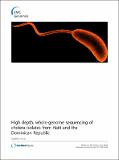High depth, whole-genome sequencing of cholera isolates from Haiti and the Dominican Republic
Author(s)
Gire, Stephen; Ellis, Crystal; Calderwood, Stephen B.; Qadri, Firdausi; Hensley, Lisa E.; Kellis, Manolis; Ryan, Edward T.; LaRocque, Regina C.; Harris, Jason B.; Sabeti, Pardis C.; Sealfon, Rachel Sima; ... Show more Show less
Download1471-2164-13-468.pdf (2.285Mb)
PUBLISHER_CC
Publisher with Creative Commons License
Creative Commons Attribution
Terms of use
Metadata
Show full item recordAbstract
AbstractBackgroundWhole-genome sequencing is an important tool for understanding microbial evolution and identifying the emergence of functionally important variants over the course of epidemics. In October 2010, a severe cholera epidemic began in Haiti, with additional cases identified in the neighboring Dominican Republic. We used whole-genome approaches to sequence four Vibrio cholerae isolates from Haiti and the Dominican Republic and three additional V. cholerae isolates to a high depth of coverage (>2000x); four of the seven isolates were previously sequenced.ResultsUsing these sequence data, we examined the effect of depth of coverage and sequencing platform on genome assembly and identification of sequence variants. We found that 50x coverage is sufficient to construct a whole-genome assembly and to accurately call most variants from 100 base pair paired-end sequencing reads. Phylogenetic analysis between the newly sequenced and thirty-three previously sequenced V. cholerae isolates indicates that the Haitian and Dominican Republic isolates are closest to strains from South Asia. The Haitian and Dominican Republic isolates form a tight cluster, with only four variants unique to individual isolates. These variants are located in the CTX region, the SXT region, and the core genome. Of the 126 mutations identified that separate the Haiti-Dominican Republic cluster from the V. cholerae reference strain (N16961), 73 are non-synonymous changes, and a number of these changes cluster in specific genes and pathways.ConclusionsSequence variant analyses of V. cholerae isolates, including multiple isolates from the Haitian outbreak, identify coverage-specific and technology-specific effects on variant detection, and provide insight into genomic change and functional evolution during an epidemic.
Date issued
2012-09Department
Massachusetts Institute of Technology. Computer Science and Artificial Intelligence Laboratory; Massachusetts Institute of Technology. Department of Electrical Engineering and Computer ScienceJournal
Stem Cell Research & Therapy
Publisher
BioMed Central Ltd
Citation
Sealfon, Rachel et al. “High Depth, Whole-genome Sequencing of Cholera Isolates from Haiti and the Dominican Republic.” BMC Genomics 13.1 (2012): 468.
Version: Final published version
ISSN
1757-6512